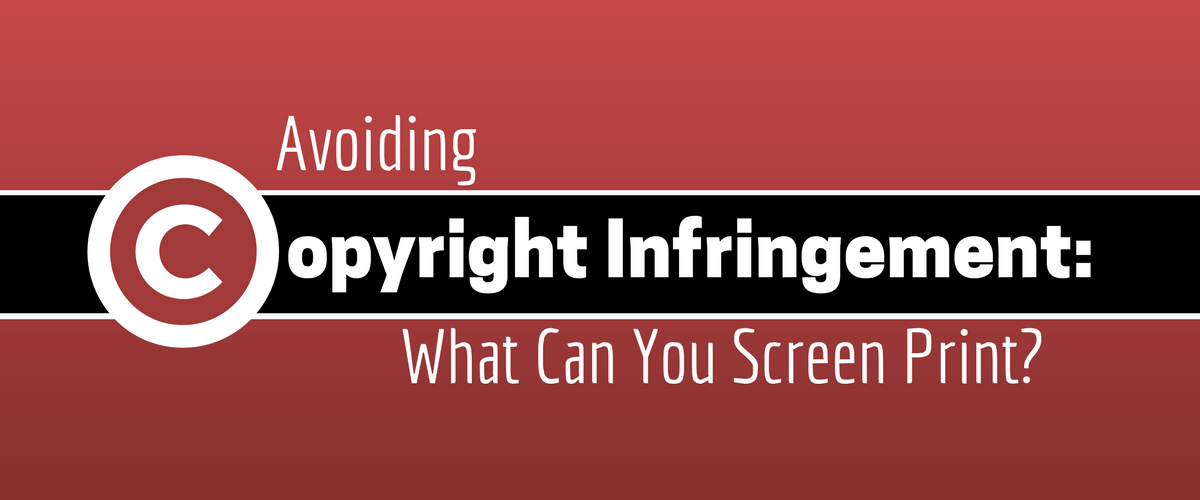

Revolucionando la industria de la serigrafía a través de tecnología de punta y servicio de calidad
Anatol Equipment Manufacturing Co.
1429 S Shields Dr
Waukegan, IL 60085


Revolucionando la industria de la serigrafía a través de tecnología de punta y servicio de calidad
Anatol Equipment Manufacturing Co.
1429 S Shields Dr
Waukegan, IL 60085

You probably already know that printing corporate, collegiate or sports logos, or book, television or movie characters without licensing can result in a costly lawsuit or fine. But copyright and trademark laws protect much more than most people realize. Some things that are protected under copyright law include:
All of the images covered by copyright laws can leave you feeling like you can only reproduce images that you’ve produced in house. While printing your own artwork surely is the easiest way to avoid any copyright problems, that doesn’t mean that you can’t use artwork from other sources. Of course, you can use any artwork that you have received licensing for, but there are other safe resources for creating artwork. For example, there are plenty of images that exist in the public domain. That is, images that were created long enough ago that any copyright protection on them has expired. Of course, clipart software contains images you’ve purchased that can be used to generate artwork that can be safely printed. You also can find sources online that lead you to artwork that’s free to reproduce. If you find an image you like, you might even find that the creator of the image will let you use it for your screen printing designs for a very low cost, or even for free.
Take the time to verify where your images are coming from, and that you do have permission to reproduce them. For many screen printers, customers bring the logos and designs to be printed. The responsibility lies with the screen printer to verify that the image can be legally reproduced. Some printer will ask customers where the designs came from in a conversational way. Other printers will ask customers to sign a form verifying that the customer has obtained rights to the image; this can both make the customer stop and think about the legality of the image while providing the print shop with some legal protection. Also, be aware of some gray areas: A local franchise might not have the right to grant permission for the reproduction of their logo, for example, and a local business might not have the ability to grant rights to reproduce the logos of the brands they carry.
Even if you’ve obtained permission to reprint logos, slogans, likenesses or other protected images, you have to know the limitations of your licensing rights. Licensing rights might only be good for a certain amount of time or a certain amount of reproductions. Oftentimes, licensing agreements will prohibit the altering of the copyrighted images in any way. Businesses often are prohibited from displaying goods with copyrighted logos as samples or in displays. If a customer has brought you an image to reproduce, you will need to verify whether you are able to use their image again, or if the printing rights only apply to that specific printing contract.
If you produce a lot of your own images or t-shirt designs, you’ll want to make sure your images are protected and won’t be stolen by other companies looking to profit from your creativity. When it comes to copyright laws, any original piece of artwork is protected from the time it is produced or published. That means you don’t have to take the time to copyright your images; they already have legal protection. However, taking the time to copyright your images, especially ones that you think will be popular or that you’re marketing on a national level, provides proof that an image belongs to you and that you were the original producer. Protecting your images can protect your creative property and even your profits. Fortunately, copyrighting images is a fast, easy and inexpensive process.
Copyrighting laws can be tricky. These tips to avoiding copyright troubles only scratch the surface. If you want to make sure your business is protected, your best route is to do your research, and do your due diligence in checking your legal rights. When in doubt, you might want to seek a professional legal opinion, and you might be best off turning away potential customers whose images stir up red flags or concerns.
Do you accept artwork supplied by your customers? Copyright issues aren’t the only problems you might face. For more tips, check out this blog post:
How to Handle the Headache of Customer-Supplied Screen Printing Artwork
Your message was successfully sent!